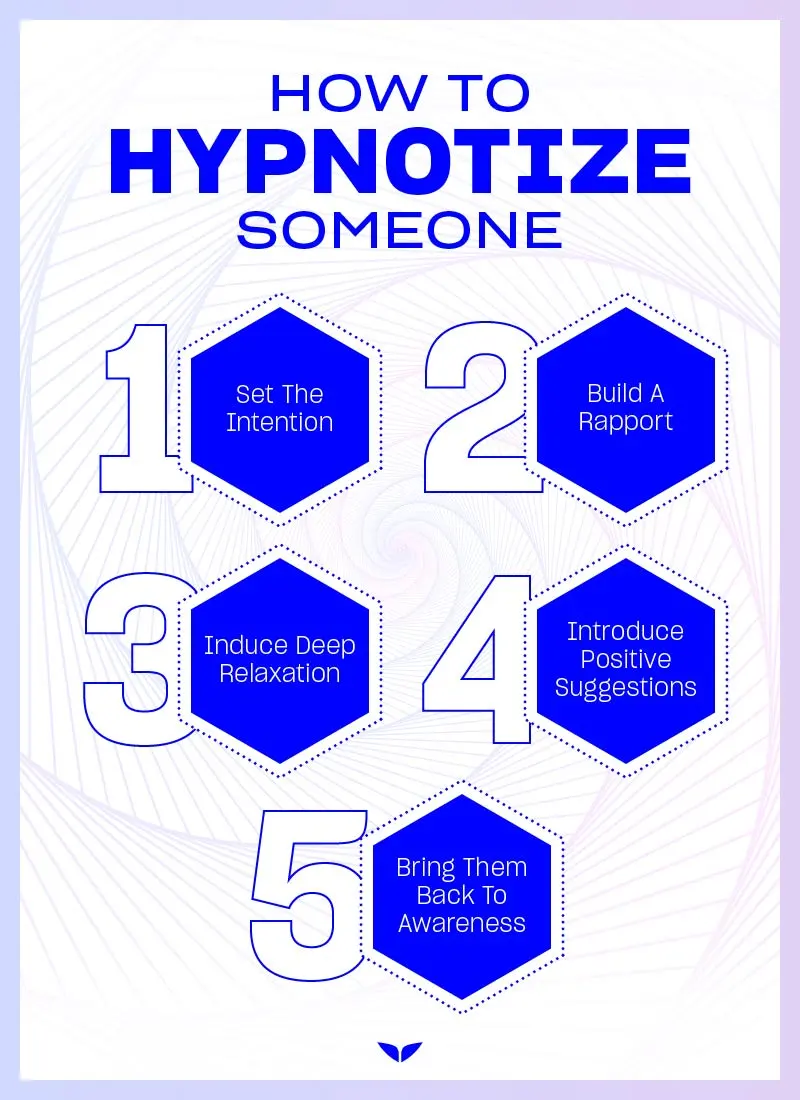Hypnosis has come a long way since the days of swinging pocket watches and chicken-clucking people.
As a matter of fact, it’s been gaining more public acceptance thanks to experts like behavioral scientist Paul McKenna. His approach to the technique, which is grounded in both science and compassion, has helped millions break bad habits, overcome anxiety, and achieve peak performance.
And as he points out in his Mindvalley Certified Hypnotherapist program, “It’s really a fantastic tool to change people’s lives for the better.”
Whether you’re curious about hypnosis or simply want to deepen your skills as a coach or therapist, learning how to hypnotize someone can help you create profound changes in people’s lives.
Can you hypnotize someone to do anything?
The short answer is no. The idea that you can put someone in a trance and do things against their will is largely a myth perpetuated by movies and stage shows. The fact is, hypnotherapy (which is the therapeutic use of hypnosis) is about empowerment.
“Hypnosis is a state of focused relaxation, not mind control,” Paul explains. “It actually gives you more control over your mind.”
This state works best when you’re open to the process and motivated for change. A 2015 study in The American Journal of Clinical Hypnosis found that receptive and willing participants respond better to hypnotic cues, but these prompts must align with their values and beliefs.
“In hypnosis, we can open up the subconscious mind and allow it to find the client other options and ways forward or to clear the limiting blocks that might be holding them back,” adds Louisa Gordon, a transformational hypnotherapist and graduate of the Mindvalley Certified Hypnotherapist program.
The bottom line is this: hypnosis involves respecting a person’s autonomy. The goal here is to guide, not control.
Ethics and responsibility in hypnosis
“It’s one of the most powerful tools in the world for behavioral change,” says Paul. But what it is not is a tool for entertainment or to impose your will on others.
Louisa suggests checking the rules and regulations for practicing in your country. As she shares with Mindvalley Pulse, in the U.K., you need special checks to be done if you are going to work with children or anyone under the age of 18.
What’s more, she explains that there are also certain areas you can’t go into unless you are a clinical hypnotherapist. Without further training, she doesn’t advise you to cover grief, depression, suicide, OCD, bipolar, PTSD, or eating disorders.
So, what else should you keep in mind when you’re learning how to hypnotize someone? Here’s a list:
- Obtain clear and explicit consent.
- Ensure the participant’s well-being is the top priority.
- Communicate openly and build trust.
- Never coerce or pressure someone into hypnosis.
- Respect boundaries and avoid using hypnosis for personal gain.
Whether it’s quitting smoking, overcoming phobias, or getting better sleep, here’s the thing to remember: When you practice it with the right intentions, hypnosis becomes a tool for meaningful, lasting change in a person’s life.
How to hypnotize someone in 5 steps
“Through hypnosis,” Paul explains, “we can get in touch with the unconscious mind, and we can program it so that in the future, you’re not frightened of getting up and speaking to a large group of people. Instead, you feel really confident.”
Here’s a live demonstration to get an idea of what he means:
If you’re learning how to hypnotize someone for the first time or even if you’re a veteran needing a reminder, the thing you should keep in mind is that there’s a process, and it should be applied with care.
Here’s the step-by-step to get you started:
1. Set the intention
According to Paul, in the state of hypnosis, a person relaxes and focuses on one singular item. And because, in this state, their focus is intensified, the switch—to quit smoking, to heal a trauma, whatever it is—that needs to be flipped, flips.
So before you even begin the hypnosis process, it’s incredibly important for the person you’re hypnotizing to set clear intentions.
“It amazes me that a lot of people, you know, they spend more time making a list for the supermarket than they do for the next five years of their lives,” the British hypnotist says. “It’s like setting off in a boat without a rudder. You could end up anywhere. So I say: have a direction, at the very least. And have some goals.”
2. Build rapport
Building rapport with the person is just as important as setting an intention. Why? Because without it, the chances of a miscommunication go up and genuine connection goes down… and the healing goes all over the place.
The thing is, the person needs to feel comfortable and safe in the hands of their hypnotherapist. And having rapport with them can do that.
“The idea with rapport is to focus on the similarities,” says Paul. For example, let’s say you notice your client is nervous and they’re speaking softly and slowly. You might respond in a similar tone and pace, saying, “I can see this is new for you, and it’s completely okay to feel that way. We’ll go at a pace that feels comfortable for you.”
There’s trust that builds when someone feels like you’re on the same wavelength as them. And when this happens, it makes them more open to the process.
3. Induce deep relaxation
“For something to happen in the real world, it has to happen in the imagination first,” says Paul. Simply put, for a person to manifest anything, they must first think of it, dream it, visualize it.
And according to him, this happens best in a state of deep relaxation where they’re being guided to imagine a better life. That could be a life without anxiety, without smoking, with a healthier version of themselves, whatever their intention may be.
Here’s how to hypnotize someone into a relaxed state:
- Begin by asking them to close their eyes and take slow, deep breaths.
- Encourage them to visualize becoming more relaxed with each breath.
- Gently guide them to release tension from specific areas of their body, starting from the eyes down to the shoulders and so on.
- Use soothing language to maintain a steady, calming tone, which enhances the persuasion effect.
Once the person is at ease, you can smoothly transition into deeper hypnotic suggestions or other therapeutic techniques.
4. Introduce positive suggestions
Here’s where the real transformation happens—it’s where negative or limiting beliefs get replaced with empowering ones.
So, let’s say the person keeps getting into one bad relationship after another. This could be due to a belief that they’re not worthy enough or that their subconscious mind is protecting them from getting heartbroken, like in their past relationship.
Positive suggestions can help flip that narrative. In fact, a review of hypnosis studies on chronic pain found that incorporating positive and supportive suggestions led to better results than focusing solely on pain relief.
Paul himself uses this method, using language that resonates with the person. “You feel confident and in control in every situation” or “You find it easy to let go of stress”…use these positive suggestions with a clear, soothing voice, and there’ll be results.
5. Bring them back to awareness
Part of learning hypnosis is also learning how to get them out of that state. Obviously, you don’t want to jolt them awake. Instead, guide them smoothly back to full consciousness.
Paul uses a counting method paired with specific affirmations that reinforce the positive feelings. Here’s what that sounds like:
“When I ask you to awaken, by counting back from 10 to one, you’ll feel refreshed, relaxed, alert, with a renewed sense of optimism and deep inner joy. And you’ll have reinforced every positive thought ever had about yourself.”
So what’s the step-by-step to this process? Let’s take a look:
- Before starting the count, set the expectation that the person will return feeling refreshed, alert, and positive.
- As you count down from 10 to one (or your preferred chosen sequence), time it in a way that follows their breathing patterns and allows them to transition gently. Between each number, include encouraging phrases, like:
- “Ten, beginning to transition back to full awareness.”
- “Nine, feeling a gentle wave of energy returning to your body.”
- “Eight, bringing back all the positive feelings with you.”
- And so on…
- As they wake up, reinforce the positive suggestions given during hypnosis.
- Once they’ve opened their eyes, take a moment to ensure they’re fully back and feeling good.
Keep in mind, the unconscious mind hears everything. So while the person may be in a hypnotic state, it takes in all the positive suggestions it was offered.

Why would you want to hypnotize someone?
Much like other types of behavioral therapy, hypnosis is one option that can be used for positive change. And it’s a tool you can use to help someone reshape their beliefs and behaviors through suggestion and persuasion.
Louisa elaborates, “It is also great when someone wants to create lasting change; we can get there so much faster and more efficiently with hypnosis because we can bypass that busy conscious mind.”
Now, for Paul, knowing how to hypnotize someone to help them get to their goal is his contribution to the world.
“If there was one gift I could give to the entire planet, it would be the ability to become relaxed at will,” he explains, “to just suddenly go into a very relaxed state of mind, a relaxed alertness where you don’t lose control but you’re just in this really great place, where you don’t feel emotionally overwhelmed, and you can make good decisions.”
When used ethically, hypnosis can help someone tap into their inner potential and discover strengths they didn’t realize they had.
Frequently asked questions
How to hypnotize someone with your voice
It’s no secret that a voice can be ultra-powerful in influencing your mood. An excited one can pump you up, an angry one can shrink you, and a soothing one can calm you down.
“Generally, hypnotherapy is done in a relaxing tone of voice,” says Paul, “a bit like a bedtime story.”
Not only the tone, though. It’s also about the pace and rhythm. And knowing how to use them in synergy can help you get the person into a deeply relaxed and focused state so that they’re more open to positive suggestions.
Here’s what you can do:
- Start by using a calm and soothing tone.
- Speak gently, with confidence.
- Slow down your talking pace.
- Keep the rhythm of your words steady and flowing.
- Pay attention to their breathing and try to match your words to it.
Sound simple enough? It can be, with practice.
How to hypnotize someone with words
Did you know that there’s a hypnotic language? According to Paul, it’s “a particular language and structures that hypnotists use that influence people.”
It’s not just what you say, but how you say it. For instance, research has found that using specific words with customers shows that you’re really listening to them. This can actually improve how they see your business and even influence their behavior in a positive way.
Here’s how you can use your words:
- Use positive language to direct the mind towards better feelings and actions.
- Use simple, clear words so that it’s easier for the subconscious to take them in.
- Imagery and metaphors help with visualization.
- Repeat, repeat, repeat—it helps solidify the message.
It’s much like that quote: “Words matter. Choose them carefully.”
How to learn to hypnotize someone
“The world has never needed hypnotherapists more,” Paul says, “with all the anxiety and stress and all the psychological problems that people need to overcome that can easily be cured with hypnotherapy.”
As he highlights in his Mindvalley Certified Hypnotherapist program, learning how to hypnotize someone isn’t about memorizing scripts or steps. Rather, it’s about understanding how the mind works and knowing how to connect with people on a deeper level.
If this is something you’re interested in, here are some steps you can take:
- Find a quality course or mentor. It can be online or in person, whichever you prefer. But here’s the most important thing: learning from an expert like Paul or enrolling in a structured program can give you the right foundation.
- Practice regularly. Work with friends or family members (even Paul did). Pay attention to how they respond to different techniques.
- Study human behavior. Hypnosis is deeply connected to how people think, feel, and behave. Understanding psychology, communication, and body language can give you an edge in mastering this skill.
- Get feedback. Learn from your experiences, listen to feedback, and continuously refine your approach.
“If you are someone who actually wants to create lasting change for people in a simple, effective way, then hypnosis is fantastic,” Louisa says. “It brings a huge tool bag of effective ways to help people, and I am always confident I can help them in a few different ways.”
Whether you’re learning to hypnotize yourself or to help others, this powerful skill can absolutely create positive change. So stay curious and stay committed.
Supercharge your superpower
You’ve seen Paul McKenna doing his thing (and if you haven’t, check out his videos online). Wouldn’t it be incredible if you’d be able to do the same? Helping someone overcome fear? Empowering someone to quit a bad habit? Guiding them to improve their self-esteem?
Now, what if you could learn these techniques from Paul himself? And better yet, through a free masterclass that has already impacted thousands of people worldwide?
Like Louisa Gordon. Or like Dr. Carolyn Nesbitt, a hypnotherapist from Canada, who says:
“For 30 years, I have used hypnosis as a tool with my therapy clients. The Mindvalley Hypnosis Certification program brought my skills to a whole new level! … Within weeks, I was tweaking how I used hypnosis, and now, after four months of practice, newly learned methods are ingrained in me.”
You, too, could start gaining these transformational skills—no matter your experience level—quickly and effectively. And your first step is at the Mindvalley Certified Hypnotherapist masterclass.
Welcome in.










